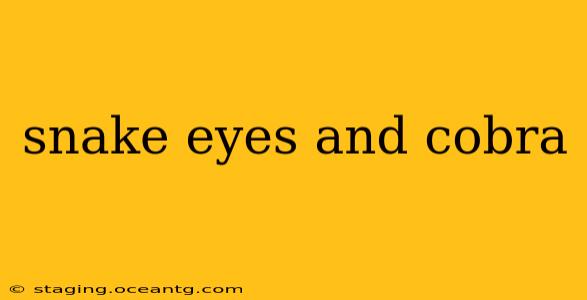The terms "snake eyes" and "cobra" often evoke images of danger and intrigue. While seemingly disparate, they connect through the realm of venomous snakes. This article delves into the meaning of "snake eyes," explores the diverse world of cobras, and addresses common questions surrounding these captivating yet potentially perilous creatures.
What Does "Snake Eyes" Mean?
The term "snake eyes" typically refers to the appearance of a snake's head, specifically the arrangement of its eyes and facial features. It doesn't necessarily denote a specific species but rather a descriptive term. In common parlance, it might be used to describe a snake perceived as particularly menacing or dangerous due to its intense gaze or unique head markings. Some might even associate it with a feeling of foreboding or a sense of imminent threat. However, it lacks a strict scientific or zoological definition.
What are Cobras?
Cobras belong to the genus Naja, comprising highly venomous elapid snakes known for their distinctive hood. This hood, formed by expanding ribs, is a striking defensive display, often accompanied by a hissing sound. Cobras are found across Africa, Asia, and parts of the Middle East. Their venom is potent, primarily neurotoxic, affecting the nervous system, and can be fatal if left untreated. Different cobra species exhibit variations in venom potency, size, and behavior.
What are the Different Types of Cobras?
There's a vast diversity within the cobra family. Some well-known examples include:
- Indian Cobra (Naja naja): One of the most iconic cobras, renowned for its spectacled markings on its hood.
- King Cobra (Ophiophagus hannah): The world's longest venomous snake, feeding primarily on other snakes. Note that while called a "cobra," it belongs to a different genus.
- Egyptian Cobra (Naja haje): A significant snake in ancient Egyptian culture, depicted in numerous hieroglyphs.
- Black-necked Spitting Cobra (Naja nigricollis): Known for its ability to accurately spit venom at its attackers.
Are Cobras Aggressive?
Cobras are not inherently aggressive but are highly defensive. They will generally strike only when they feel threatened or cornered. Their hood display serves as a warning, giving potential predators or humans a chance to retreat. Unprovoked attacks are rare, but caution and respect are vital when encountering a cobra. Intrusion into their habitat or perceived threats can trigger a defensive strike.
What Happens If You Get Bitten by a Cobra?
A cobra bite is a serious medical emergency. The venom's neurotoxic effects can lead to paralysis, respiratory failure, and even death if not treated promptly with antivenom. Seek immediate medical attention, remaining calm and minimizing movement to slow the spread of venom. Knowing the specific type of cobra involved is crucial for administering the appropriate antivenom.
How Can I Avoid Cobra Bites?
Avoiding cobra bites involves a combination of awareness and preventative measures:
- Be aware of your surroundings: When hiking or travelling in areas where cobras are known to inhabit, pay close attention to where you place your feet and hands.
- Avoid disturbing snakes: Give cobras a wide berth and never attempt to handle or capture them.
- Wear protective clothing: In regions with high cobra populations, consider wearing sturdy boots and long pants to minimize skin exposure.
- Educate yourself: Learn about the different types of cobras found in the regions you'll be visiting and their typical habitats.
Conclusion
Understanding the nuances between terms like "snake eyes" and the specific characteristics of different cobra species is crucial for responsible interaction with these fascinating creatures. While fear is a natural response, knowledge and respect are the best tools for minimizing the risk of dangerous encounters. Remember, cobras are wild animals that deserve our respect and protection, and their bites represent serious medical emergencies requiring prompt professional attention.
